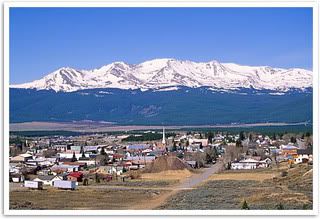
Given the history of the Leadville Mine Drainage Tunnel, you have to wonder just how much "homeland security" the federal government really cares to provide. That tunnel was apparently blocked, which caused an estimated billion gallons of water to back up behind it and start seeping from hillsides.
This water was not pure mountain snowmelt, either. It's in a mining district that has sulfide ores. When water sits amid such rocks, it becomes acidic. The acidic water dissolves minerals and carries cadmium and zinc. There are legitimate fears that the toxic water could push past the blockage and surge out the portal, then down to the Arkansas River, sweeping away some homes as it destroyed aquatic life as far down as Pueblo Reservoir, more than 100 miles away.
What Leadville is doing to deal with this danger:
LEADVILLE, Colo. - Emergency sirens and loudspeakers have been tested and sensors installed. Bulldozers have cut an escape route. Townspeople have been warned to assemble "grab-it-and-go" kits with first aid supplies, water, flashlights and blankets.Nice touch, that last sentence.
A concealed threat is hanging over this old Wild West mining town: A billion gallons of toxic water is trapped in a collapsed drainage tunnel in the hills overlooking Leadville and could blow at any moment with devastating effect, sweeping away mobile homes in the town of 2,600.
[snip]
Between the mid-1800s and the 1990s, gold, silver, lead, zinc and finally molybdenum, a substance used to harden steel, were extracted from the ground around this 10,200-foot-high town 100 miles west of Denver.
In the 1940s and '50s, the federal government built a two-mile mine drainage tunnel to carry off contaminated rainwater and snowmelt into the Arkansas River. But a tunnel collapse that was detected in 1995 caused water to back up behind the rubble.
Because of years of bickering between the state and the federal government over what to do about the buildup and who would assume responsibility for it, nothing was done and the water kept rising, finally prompting nervous Lake County officials to declare a state of emergency on Feb. 13.
[snip]
On Wednesday, the EPA began pumping water out of a nearby shaft to try to relieve pressure on the tunnel. In about five weeks, the EPA will drill into the tunnel and pump water directly out of it.
"I'm angry. No, I'm damn angry," said county Commissioner Mike Hickman. "I have three heads of federal agencies here who I'd like to call The Three Stooges. Three years ago they knew what the problem was." Of the emergency declaration, he said: "It's a shame that we need to come to this sort of display to get the attention of these federal agencies."
Not everyone here was thrilled with the emergency declaration. The mayor said it came as a surprise to city officials, who later learned that the city's liability insurance carrier was canceling its policy.
Update 3/11:
Bureau of Reclamation engineers Monday were able to treat 2,100 gallons per minute of contaminated water at the Leadville Mine Drainage site, a rate that gives them confidence that cleanup can be successful.Good job, guys. Nice to see that someone is actually caring about the environment and trailer parks.
The Leadville Mine Drainage Tunnel is supposed to drain water from the mine but collapsed more than a decade ago, and water has built up ever since.
Officials fear that the pressurized water could burst through the tunnel or an earthen dam, sending zinc-, cadmium- and lead-laced water through a trailer park and into the Arkansas River.
Pumping the water out is complicated by the fact that the water is contaminated with heavy metals from Leadville's long mining history.
The risk caught the attention of federal lawmakers who last month pressured the bureau to take prompt action.
Monday, beginning at 8 in the morning, Reclamation engineers began increasing the amount of water being treated at the drainage tunnel's treatment plant, in 200-gallon-per- minute increments.
When the rate reached 2,100 gallons per minute, they kept it there for several hours, before easing back to 1,100 gallons per minute, said Peter Soeth, spokesman for the bureau.
The more metal in the water, the slower the treatment must go, so the fact that 2,100 gallons per minute could be sustained is satisfying.
The EPA should complete its well and the piping to Reclamation' s treatment plant by late May, Soeth said.
At a rate of 2,100 gallons per minute, it could take about a year to treat the 1 billion or so gallons of water trapped inside the mine.
4 comments:
Two words: movie rights.
Come on, you didn't expect an insurance company to continue coverage if there was a chance the people who have been paying them premiums for decades might file a claim?
I don't guess drilling a hole and siphoning it out occurred to anyone during the last decade? If you siphon from the top you don't pick up the heavy metals.
The EPA is pumping water out of one of the shafts, but I don't know how much water they have removed.
The idea that the toxins will wash into the Arkansas River should be a concern as well. A lot more than just Leadville is at stake.
And yes, I did expect the insurance company to stick around and pay back what was paid in. ... not really. The bastards.
Shrimplate, lol! I don't think I could stand it.
The Night Leadville, Colorado Moved to Kansas.
Post a Comment